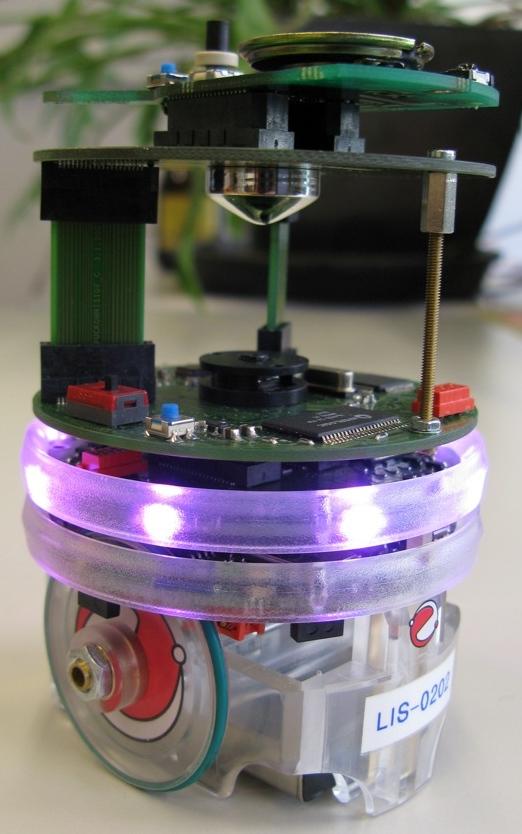Robots decipher animal communication strategies
January 6, 2012

The e-puck robot is equipped with sensors to detect the food source, a light-emitting diode ring, and an omnivision camera to detect the light signals of other robots (credit: UNIL/EPFL)
A joint research project using robots, conducted by researchers at the University of Lausanne (UNIL) and EPFL, showed that communication systems can evolve differently within the same species and even the same environment. The research could enable a better understanding of communication within the animal kingdom.
Scientists followed the evolution of communication in 100 groups of 20 robots over the course of 1000 generations. The robots were equipped with a camera that detected the environment, wheels, and a ring enabling them to emit emit blue and green light signals.
Positioned in arenas, they had to locate a source of virtual food that was only visible when they came upon it. Their behavior was guided by a neural network controlled by genes that could evolve through mutation and selection in the course of successive generations.
An initial experiment showed that the robots rapidly developed communication systems that enabled them to transmit information about the location of the food to their peers. Using a single color to indicate the location of the food proved more effective that a system using two colors, one pointing towards the food and the other towards the remaining part of the arena.
It also became evident that a population that has evolved towards a relatively effective type of communication doesn’t subsequently change it, since it would then be necessary to simultaneously modify the way the information is transmitted, and also the way of responding. In other words, a communication system, just like a language, cannot change rapidly through generations.
This research also showed the importance of random factors in evolutionary processes. The experiment, performed in 20 homogenous groups (with robots of the same type) showed that half of them chose the single-color strategy, whereas the other half opted for the more complex two-color system (which won out in a second experiment).
“We know that in the animal kingdom communication systems are very complex, and this diversity evolved over a very long period of time,” says UNIL researcher Laurent Keller. “Our experiment shows how it occurs, and reveals that environmental factors are not the only ones involved, as one might believe. The robots shed new light on these evolutionary processes.”
Ref.: Steffen Wischmann, Dario Floreano, and Laurent Keller, Historical contingency affects signaling strategies and competitive abilities in evolving populations of simulated robots, PNAS, 2011 [DOI: 10.1073/pnas.1104267109]